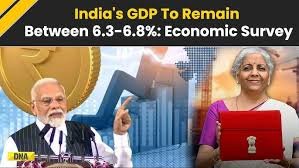Economic Survey 2025: Nirmala Sitharaman Tables the 2024-25 Report – A Detailed Analysis
Overview of the Economic Survey 2025
The Economic Survey 2025, presented by Union Finance Minister Nirmala Sitharaman, outlines the state of India’s economy for the year 2024-25. The report, which serves as a precursor to the Union Budget, provides a detailed analysis of various economic indicators, growth projections, and the government’s fiscal strategies. The Economic Survey not only assesses the country’s economic performance but also offers an insight into policy measures that will drive future economic growth. It has a significant role in guiding government policy and informing students and professionals preparing for competitive exams, particularly those related to public administration, economics, and governance.
Key Highlights of the Economic Survey 2025
The Economic Survey 2025 emphasizes various aspects of India’s economic performance, including GDP growth, inflation trends, employment statistics, and fiscal health. The Survey forecasts a GDP growth of 6.5% for 2024-25, indicating resilience amidst global economic challenges. Other key points include a stable inflation rate, improved foreign direct investment (FDI) inflows, and a targeted fiscal deficit reduction. Additionally, the Survey focuses on sectors such as agriculture, manufacturing, and services, highlighting reforms and government initiatives designed to boost growth in these areas.
One of the major aspects discussed is the government’s focus on the digital economy, with a robust push for digital infrastructure, which is expected to play a central role in India’s economic growth. The Survey also sheds light on social welfare programs, including health and education, aimed at improving human capital and boosting long-term economic stability.

Why This News is Important
The Economic Survey 2025 plays a vital role in shaping India’s economic and fiscal policies. It provides a roadmap for both short-term and long-term growth strategies. For students preparing for competitive exams, understanding the nuances of the Economic Survey is essential as it is a crucial part of the syllabus for subjects such as economics, public administration, and current affairs.
The Survey offers a detailed analysis of the country’s economic challenges and growth prospects. Its implications on key sectors like agriculture, industry, and services are vital for understanding government priorities and initiatives. Furthermore, the emphasis on fiscal discipline, inflation control, and sustainable growth forms the foundation of the upcoming Union Budget, making this an essential read for those aiming to work in civil services, the banking sector, or any government-related role.
In the context of exams, questions related to economic policies, growth forecasts, and fiscal policies from the Economic Survey are frequently asked. It also helps candidates develop a comprehensive understanding of India’s macroeconomic environment, a critical aspect of governance and policy-making.
Historical Context
The Economic Survey, an annual document presented by the Ministry of Finance, has been a part of India’s budgetary process since 1950. It provides an in-depth analysis of India’s economic progress, challenges, and outlook. Over the years, the Economic Survey has evolved to reflect global trends and domestic needs, adapting to the changing economic environment.
Historically, the Economic Survey has been a vital document for policymakers and government officials, offering insights into the performance of various sectors and helping in the formulation of budgetary proposals. It sets the tone for the Union Budget by providing a comprehensive economic analysis and highlights critical sectors that need attention.
In the current context, the 2024-25 Economic Survey assumes importance as it sets the stage for India’s recovery post-pandemic, amidst the ongoing global economic uncertainties. The Survey also reflects India’s growing role in the global economy, with a focus on digital transformation and sustainable growth.
Key Takeaways from the Economic Survey 2025
| S. No. | Key Takeaway |
|---|---|
| 1 | The Economic Survey forecasts a GDP growth of 6.5% for 2024-25. |
| 2 | The Survey highlights stable inflation and a reduction in fiscal deficit targets. |
| 3 | Significant focus on digital economy and infrastructure development. |
| 4 | The government’s emphasis on boosting sectors like agriculture, manufacturing, and services. |
| 5 | The Survey outlines the importance of social welfare schemes in driving human capital growth. |
Important FAQs for Students from this News
Q1: What is the significance of the Economic Survey 2025?
The Economic Survey 2025 provides a detailed analysis of India’s economic performance, including projections for GDP growth, inflation, and fiscal health. It sets the stage for the Union Budget, helping policymakers and students understand key government priorities and economic strategies.
Q2: What is the GDP growth forecast for India in the Economic Survey 2025?
The Economic Survey 2025 forecasts a GDP growth of 6.5% for the fiscal year 2024-25, indicating resilience amid global challenges.
Q3: What sectors are emphasized in the Economic Survey 2025 for growth?
The Survey emphasizes sectors such as agriculture, manufacturing, services, and digital economy infrastructure. These sectors are seen as critical for driving economic growth in the coming years.
Q4: How does the Economic Survey 2025 impact students preparing for government exams?
The Economic Survey provides important insights into India’s economic policies, government strategies, and growth forecasts, making it crucial for students preparing for exams like IAS, PSC, banking, railways, and civil services.
Q5: What does the Economic Survey say about fiscal policy?
The Economic Survey discusses the government’s targeted fiscal deficit reduction, fiscal discipline, and efforts to stabilize inflation, offering a clear picture of India’s fiscal health and financial strategy.
Some Important Current Affairs Links


















